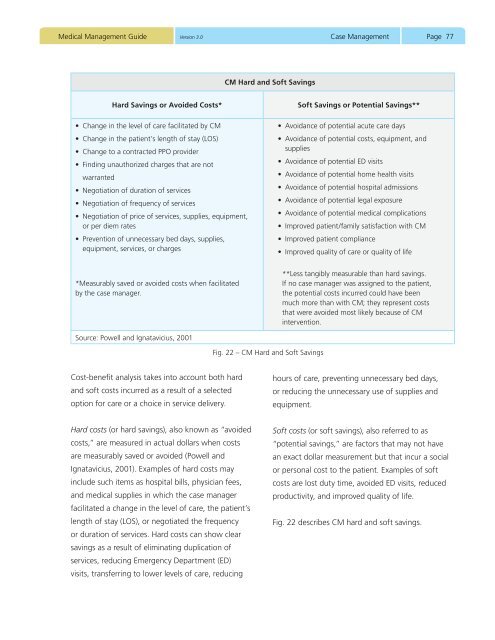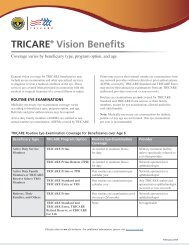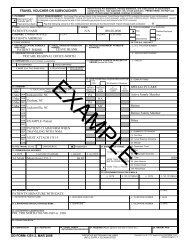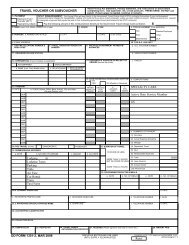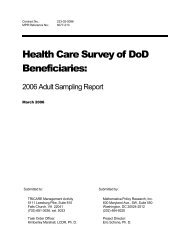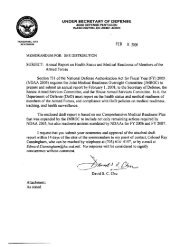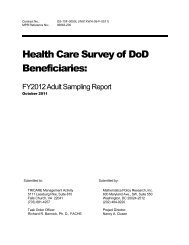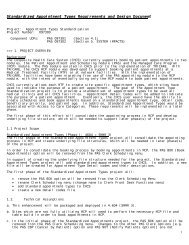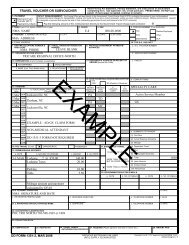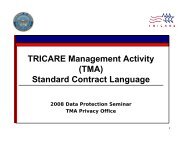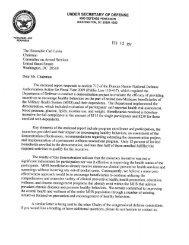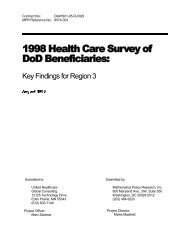Medical Management Guide, 2009, Version 3.0 - Tricare
Medical Management Guide, 2009, Version 3.0 - Tricare
Medical Management Guide, 2009, Version 3.0 - Tricare
- No tags were found...
You also want an ePaper? Increase the reach of your titles
YUMPU automatically turns print PDFs into web optimized ePapers that Google loves.
<strong>Medical</strong> <strong>Management</strong> <strong>Guide</strong><strong>Version</strong> <strong>3.0</strong>Case <strong>Management</strong>Page 77CM Hard and Soft SavingsHard Savings or Avoided Costs*• Change in the level of care facilitated by CM• Change in the patient’s length of stay (LOS)• Change to a contracted PPO provider• Finding unauthorized charges that are notwarranted• Negotiation of duration of services• Negotiation of frequency of services• Negotiation of price of services, supplies, equipment,or per diem rates• Prevention of unnecessary bed days, supplies,equipment, services, or chargesSoft Savings or Potential Savings**• Avoidance of potential acute care days• Avoidance of potential costs, equipment, andsupplies• Avoidance of potential ED visits• Avoidance of potential home health visits• Avoidance of potential hospital admissions• Avoidance of potential legal exposure• Avoidance of potential medical complications• Improved patient/family satisfaction with CM• Improved patient compliance• Improved quality of care or quality of life*Measurably saved or avoided costs when facilitatedby the case manager.**Less tangibly measurable than hard savings.If no case manager was assigned to the patient,the potential costs incurred could have beenmuch more than with CM; they represent coststhat were avoided most likely because of CMintervention.Source: Powell and Ignatavicius, 2001Fig. 22 – CM Hard and Soft SavingsCost-benefit analysis takes into account both hardand soft costs incurred as a result of a selectedoption for care or a choice in service delivery.hours of care, preventing unnecessary bed days,or reducing the unnecessary use of supplies andequipment.Hard costs (or hard savings), also known as “avoidedcosts,” are measured in actual dollars when costsare measurably saved or avoided (Powell andIgnatavicius, 2001). Examples of hard costs mayinclude such items as hospital bills, physician fees,and medical supplies in which the case managerfacilitated a change in the level of care, the patient’slength of stay (LOS), or negotiated the frequencyor duration of services. Hard costs can show clearsavings as a result of eliminating duplication ofservices, reducing Emergency Department (ED)visits, transferring to lower levels of care, reducingSoft costs (or soft savings), also referred to as“potential savings,” are factors that may not havean exact dollar measurement but that incur a socialor personal cost to the patient. Examples of softcosts are lost duty time, avoided ED visits, reducedproductivity, and improved quality of life.Fig. 22 describes CM hard and soft savings.


